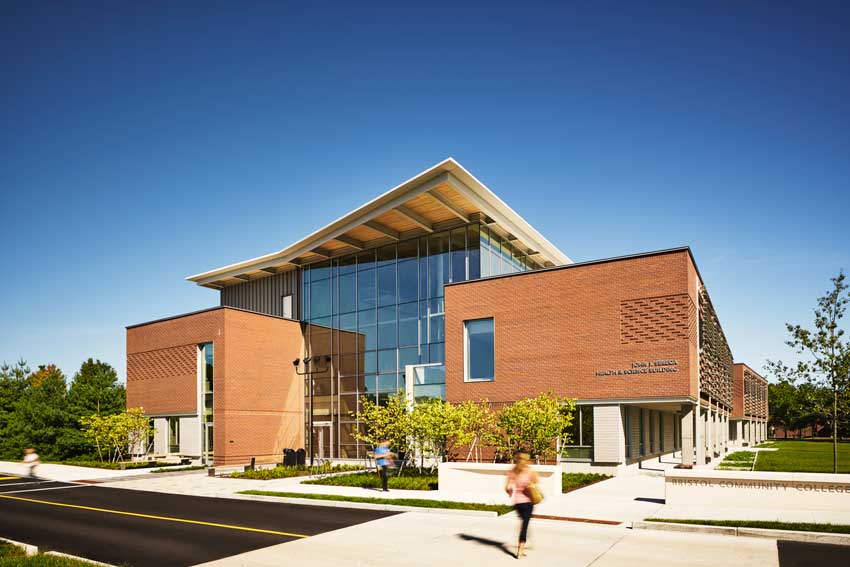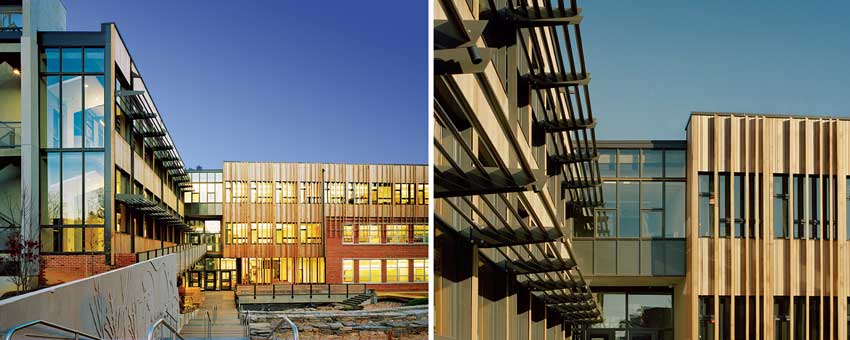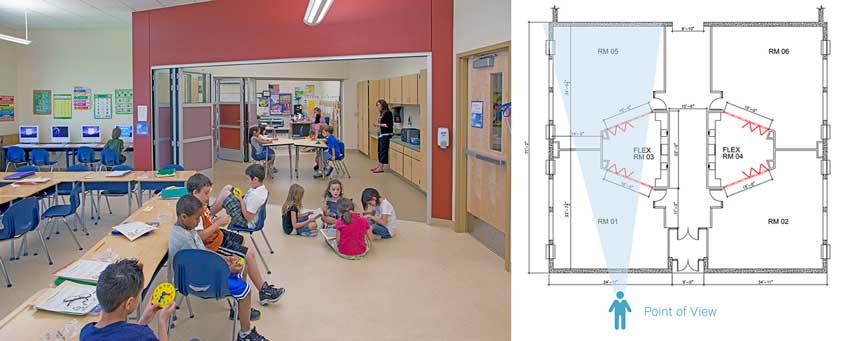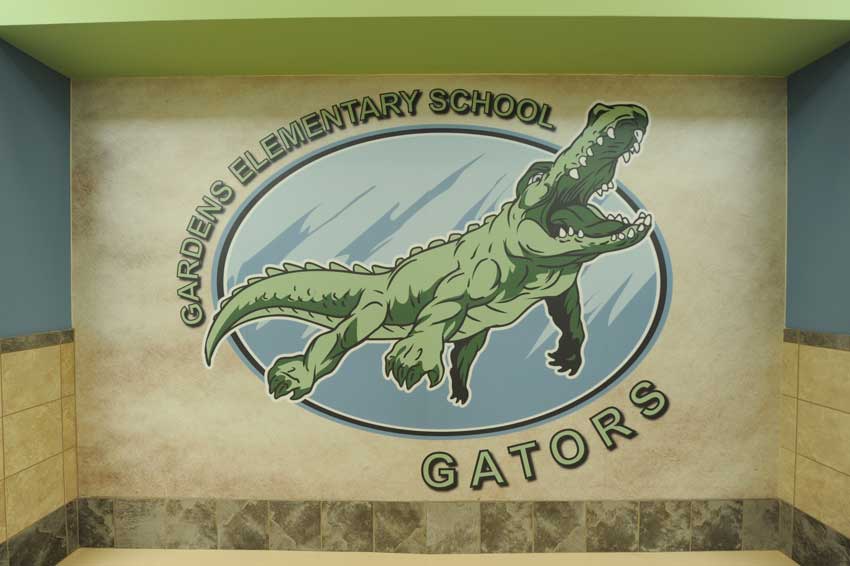Architecture for Education
Using research-based information to make better design decisions
![]() Continuing Education
Continuing Education
Use the following learning objectives to focus your study while reading this month’s Continuing Education article.
Learning Objectives - After reading this article, you will be able to:
- Identify the significance of using independent research as a basis for making design decisions in schools.
- Assess the health and safety performance aspects of a variety of design characteristics and materials as they relate to durability and sustainability.
- Explain the importance of making design decisions that have positive impacts on student performance, indoor air quality, and health.
- Determine ways to incorporate the design principles presented into buildings that are sustainable and high performing as shown in case studies.
Designing K–12 learning environments is a task of considerable complexity requiring a great deal of information gathering, analysis, and synthesis to produce a successful final design. Some of the information is based on the stated needs and desires of a school client board, staff, or regulatory and funding authority. Other information is based on the physical parameters of an existing site or building that is the focus of a new or updated facility. But there is an additional source of information that can be highly valuable in making informed decisions on the ways that a school environment can be successful, namely independent scholarly research. In a world where information has become the new driver of so much of our activities and economies, research that is vetted and found to be reliable can help clarify facts from opinions and offer insights into multiple aspects of architectural design. As such, useful research is not limited just to that done in architectural schools or firms, but from many disciplines of art, science, technology, health, and others. Since architecture has always reflected, and often contributed to the culture of a particular place and time, it is no surprise that all of the disciplines and forces of our current culture come into play in the design of new or renovated schools today.
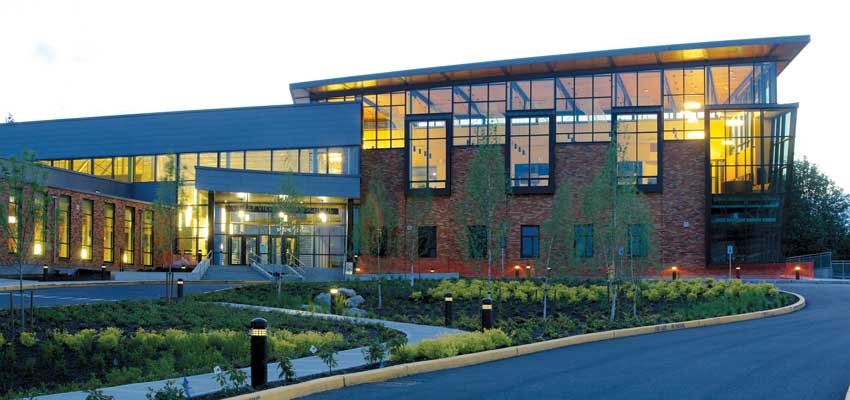
© Matt Todd Photography/Guardian Glass
School design can benefit from advances in research, development and testing focused on a wide variety of disciplines, including building science and human impacts. The Valley View Middle School in Snohomish, Washington, designed by Dykeman Architects, shown here, benefitted from research based design to create a building that would “achieve sustainability and teach stewardship of the environment” while saturating the building with natural light and providing panoramic views.
Recognizing the multiplicity of influences on school design, The American Institute of Architects (AIA) Committee on Architecture for Education (CAE) has been formed with more than 8,000 architects and allied professional members. It is a knowledge community and think-tank group committed to “enhancing educational facilities through thoughtful, research-based, and collaborative programming, planning, and design.” As part of this mission, the AIA CAE has created a Research Subcommittee to help bridge the gap between practice and research. The goal is to provide AIA members and other design professionals with a “national interdisciplinary working group focusing attention on the influential interactions, dynamics, and cultural influences that occur within and around physical learning environments in which the learner, teacher, content, and affordances interact within the context of the built environment.” In essence, they are seeking to draw from a broad pool of information to provide practitioners engaged in school design with some reliable research upon which to justify and base design decisions. This approach, often referred to as research-based design, means that architects can be kept up to date with the latest information in a manner that allows us to translate research knowledge into built conditions. (Learn more on the CAE Research webpage.)
Toward the end of improving communication, the AIA CAE Research Subcommittee has launched an effort with Learning by Design and published its first issue of Dialogues in fall of 2017. This succinct document provides five summaries of research projects that provide fresh perspectives connecting “health and learning through co-creative design processes, physical activity, multisensory experiences, and encounters with space as a teaching tool.” The Subcommittee co-chairs say, “With these touchstones of understanding the deeper intersections between environment and learning, we can begin to nourish expansive conversations around the planning, building, and evaluation of school in the future.”
Using work of this research subcommittee for inspiration, this course will address seven common areas of school design and seek to question the basis for design decisions around them. In essence, it is intended to be a call to action for designers to question if they are using research in their design to keep their designs fresh and current or making decisions purely based on quickly fading traditions or past practices.
Daylight and Glazing
One area that is well known for incorporating research-based design is the use of natural daylight to enhance the effects on people in buildings, particularly schools. Numerous studies have indicated that students perform better when they are in classrooms and other school spaces that contain natural daylight. The design challenge comes in the form of not only controlling that daylight but also in finding the balance between appropriate lighting and energy usage. Since any window or glazed opening will allow heat as well as light to pass through it, the treatment of glass has received considerable research attention.
Research, development, and testing have been done by a variety of organizations including institutions, third-party agencies, and manufacturers to identify coated glass products that can deliver high light transmittance while reducing solar heat gain. Such products are ideal for creating learning spaces with abundant natural light while helping to manage heating and cooling costs and the need for artificial lighting. Specifically, glass coatings can be tailored to achieve the right combination of thermal U-factor, solar heat gain coefficient (SHGC), and visible light transmission (VT). So, for example, a solar heat gain coefficient of 0.25 or less may be required in warmer climates, which would commonly mean a large loss in VT. Through research and development, coated glass products are now available that achieve SHGC of 0.23 and corresponding VT up to 68 percent. The color of the primary glass can be selected to suit a particular aesthetic and performance level with a variety of float glass colors, including low-iron (very clear), light gray, and light blue. The neutral appearance of the low-iron glass with a coating is the most similar to clear uncoated float glass, which has a normal green tint from the manufacturing process. Selecting the best version of such coated, insulating glass can help a project earn certification from green building rating systems such as LEED, the Living Building Challenge, and the WELL Building Standard.
Brian Schulz is a product manager with Guardian Glass North America. He observes, “What used to be a trend in school construction—maximizing daylight—is now the standard, and now we must deliver products that bring abundant natural light into spaces while delivering on strict energy-performance requirements. Coated glass products give architects and designers a wide selection of performance and aesthetics to meet even the most complicated specifications.” From a designer’s perspective, Denis Henmi, FAIA NCARB, president of the firm Kwan Henmi, concurs. “The exterior appearance of the glazing is of top priority,” he says. “We go through a very careful selection process balancing the aesthetics and performance characteristics. Maximizing views and natural light are some of the top goals during the design process. Coated glass has played a vital role in our ability to maximize glazing, energy performance, and visual appearance.”
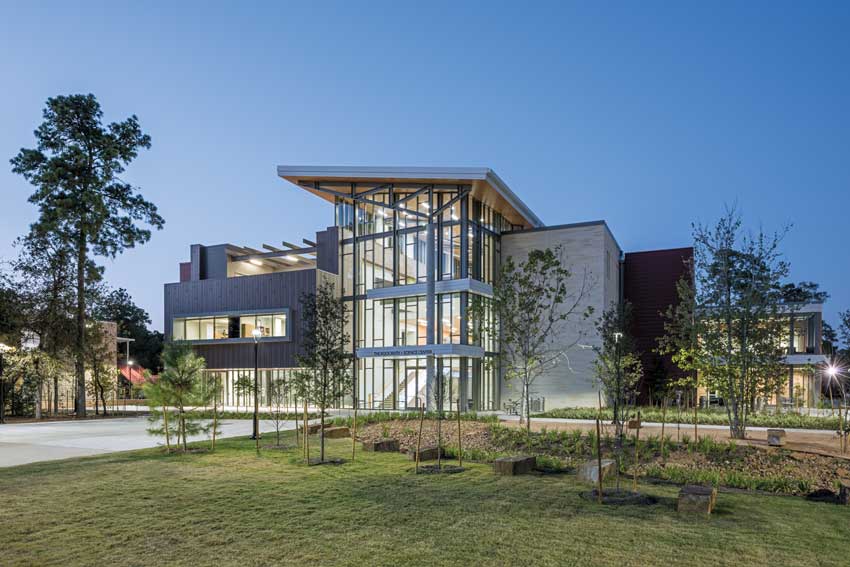
© Ziegler Cooper Architects/Guardian Glass
Incorporating high-performance coated glass, the John Cooper STEM School in Houston designed by Ziegler Cooper Architects includes a dramatic glass entrance that incorporates eye-catching aesthetics with a high level of light transmission coupled with low solar heat gain. This glass performance helps architects meet the most stringent energy codes in North America without sacrificing appearance.
Sun Controls
While allowing natural daylight into a building is proven to improve well-being and productivity in schools, excessive daylight can lead to uncomfortable glare and, depending on the compass orientation or time of day, could add more solar heat gain than desired. For these reasons, providing a solution for controlling or directing daylight into interior spaces is important for a successful outcome. Research indicates that there are different design options that can yield the sought-after results.
Exterior Sunshades
Exterior sunshades have become a common and popular design solution, as they let filtered light into a building while still allowing occupants to see out. They are particularly attractive to architects because exterior sunshades are fully customizable to suit the design of a particular project or facility. Different components are available to create a complete system, including an array of patterns, hues, textures, and lighting. “Exterior sun shade systems provide lower energy costs and reduce glare by allowing filtered light to enter a building,” says Eric Sposito, national sales manager with Construction Specialties. “They can be used to create unique architectural designs with intricate patterns, sleek textures, vivid colors, and even LED lighting. No matter how complex the architectural facade may be, an engineered sun shade solution is possible.”
Cantilevered and suspended sunshades typically project horizontally outward from the building facade, and as such are well suited for southerly facing facades. The location and angle of the horizontal bands can be adjusted to suit a project based on specific orientation, latitude location, and facade conditions. This type of sunshade is also ideally suited for installations where loads from wind and snow need to be distributed over a larger area and back to the buildings structural support system. Instead of cantilevering outward from the building, exterior sunshades can alternatively be suspended closer to the facade in either a horizontal or vertical format. This configuration is particularly well suited for east and west elevations, where low sun angles make sun control challenging.
For installations where daylight from any direction is intended to offset the use of electric lights, something is needed to help distribute the daylight evenly into interior spaces such as classrooms. Interior light shelves have been successfully employed to do just that, particularly when combined with upper or transom style windows. These light shelves intercept the upper light and redirect it deeply into the building. In this way, they reduce heat and glare, allowing students to sit adjacent to windows comfortably and productively.
When properly designed, exterior sunshades allow filtered light to enter interiors and let occupants see out. Manufacturers of exterior sunshades can also demonstrate how their products can enhance building designs while lowering its environmental impact. For some though, manufacturing the product is just the beginning. When architects are looking for an exterior sunshade solution, certain manufacturers can also provide expert guidance and engineering support in the final design and fabrication of products directly suited to individual projects. Architects can work with product engineers to design a custom system that is code compliant and structurally sound, regardless of how complex the final design may seem.
Integrating exterior sun shades into a building can be addressed through custom design options available. BBH Design Associate Tzu Chen, AIA, specified horizontal sunshades at Wake Technical Community College. He comments, “Seeing the final product, we definitely feel that the sunshades blend well with all of the [building’s] components. The abruptness of the transitions was a consideration, but it worked out nicely.”
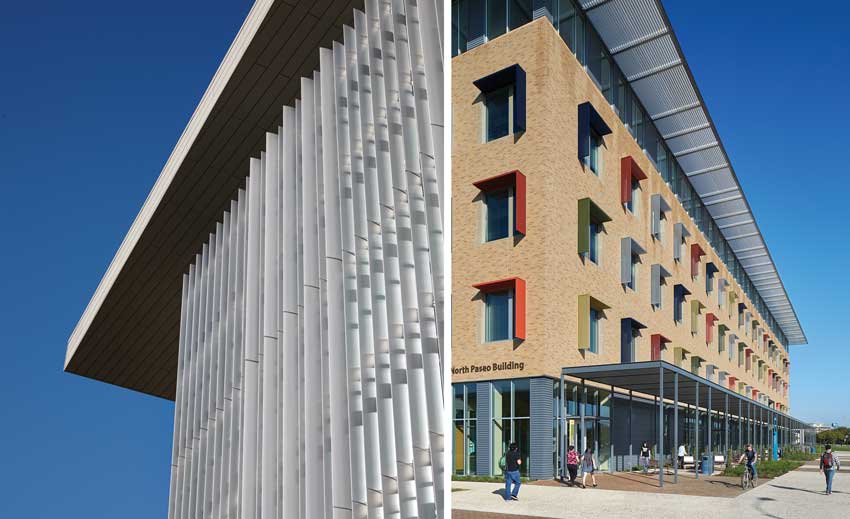
Photos courtesy of Construction Specialties
Exterior sun shades can be incorporated in a variety of ways on a building, including horizontal or vertical installations. Properly designed and installed, they can reduce glare, improve the quality of daylighting, and still allow for views out of windows.
Interior Sun Shades
Controlling daylight and glare from the inside of a building is a design option in many cases for school buildings. Roller shades in windows have commonly been used, which allow a great deal of flexibility and control. Fully open, they can allow for full penetration of daylight and clear views to the outside for students. For times when solar control is needed to reduce glare, they can be closed fully or partly, with options available for the shade material to be either opaque or textured to intentionally obscure light transmission and visibility. In some cases, it may be desirable to provide both options in a single installation. The textured choice still allows diffused daylight to pass through, but the fabric appearance of the shade reduces the total light, thus reducing glare and producing a favorable light quality inside the building. An opaque or room darkening choice can be helpful for times when audio visual equipment is in use, which requires a lower ambient lighting condition.
Interior sun shades can help with the rejection of solar heat and have a positive impact on reducing energy needs for cooling as a result. For example, independent research using computerized energy models run for a medium-sized, two-story building in the Midwestern United States compared a baseline building with no window shades to a building design that incorporated interior sun shades. Different types of shades were modeled that ranged in the percentage of openness in the fabric (i.e., less openness equals more shade fabric per square foot). The results of the modeling and analysis showed that annual energy savings related to space cooling, heat rejection, and ventilation fans could be realized between 5 to 9 percent. These savings were attributed to the ability of the fabric to reflect solar heat and keep the building from overheating on sunny days. Hence, this data shows that it is possible to provide daylighting while still having a positive impact on overall energy use in a building.
Any product used on the interior of a school building needs to be durable in order to be practical. In the case of interior window shades, this comes in two forms. First is the shade or curtain material itself, which in this case can be specified from available, nonorganic, resilient fabrics. Second is the roller mechanism, which can be provided by manufacturers in a durable, concealed housing. The operation can be cordless to further ensure durability and create a cleaner, safer operation.
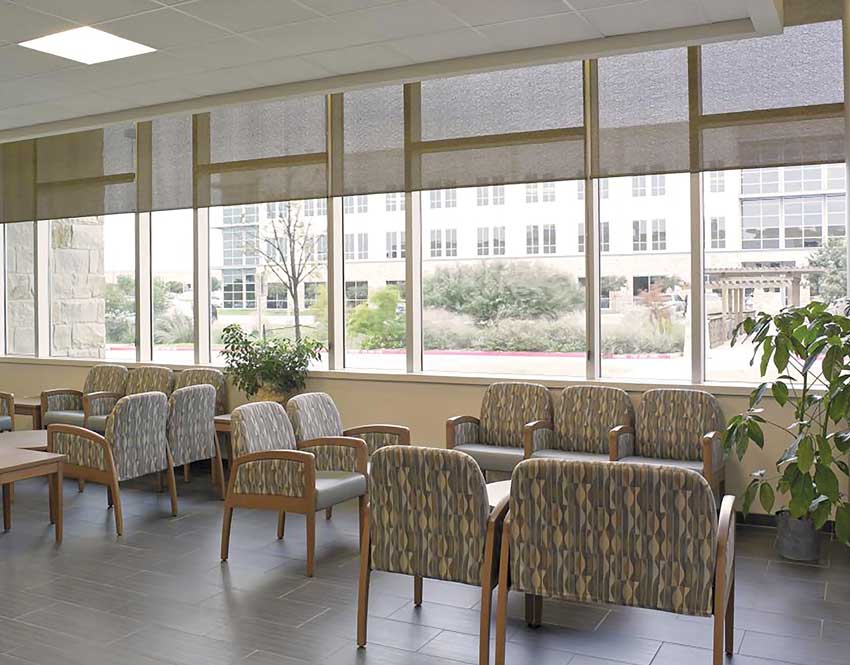
Photo courtesy of Inpro
Interior solar shades can reduce glare while still providing daylight and views. The type of fabric used can be selected for durability, aesthetics, and solar reflectance to help reduce energy costs for cooling.
Thermal Comfort
When it comes to creating a school building that is thermally comfortable, accommodating to daylighting and sun, and efficient to operate, the focus often moves from a well-designed building envelope to an efficient cooling and heating system. While mechanical engineers are quite good at figuring out the sizing, efficiency, and economics of different systems, architects are usually more concerned with flexibility in design, quiet operation, availability of indoor unit styles, and being able to modify the systems as needs change during the design or life cycle of the building. From all points of view, variable refrigerant flow (VRF) systems have become a popular choice to provide educational buildings with design flexibility and efficient, personalized comfort for occupants. Because they can be customized and easily zoned to provide cooling or heating simultaneously throughout a building, they meet the needs of a wide variety of spaces, including classrooms, lecture halls, administrative offices, athletic facilities, and more.
Design teams who have incorporated two-pipe VRF systems have found them easy to design, while facility operators find them easy to manage and modify as building needs change. Routine maintenance is minimal and limited to indoor unit filter changes and outdoor unit condenser coil cleanings. With this ease of design and installation, minimal required maintenance, superior energy efficiency, and long-lasting equipment, the systems’ total life-cycle costs are less than many others. More importantly, the capability of precise zoning gives individual control to teachers and administrators, keeping virtually everyone comfortable and content. From an operations standpoint, cooling and heating can be utilized in areas that need it, without paying for those that don’t.
The quiet nature of VRF systems makes them ideal for environments like libraries, classrooms, and study halls, where students need to focus without the distraction of noise. Indoor units operate down to 19 dB(A), quieter than a whisper, and outdoor units featuring high-performance compressors operate at levels as low as 58 dB(A). Energy recovery ventilators (ERVs) can also be applied to exhaust outside air and rid the school of toxins, odors, bacteria, and other potentially harmful contaminants. They also improve HVAC system efficiency by preheating or cooling incoming outside air with energy recovered from the exhaust air.
Nichole Watring is the principal at St. Joseph School in Pilot Grove, Missouri, where VRF systems have been successfully installed. She notes, “We have not had any issues with the system, and the teachers and students love that they can control the temperature of their rooms. It’s much quieter and more efficient than the previous system. The students especially love the burst of cool air when they come in from recess on hot days.”
Kevin Miskewicz, director of commercial marketing for Mitsubishi Electric Cooling & Heating, is always glad to hear success stories like this, as he points out, “We understand the challenges educational facilities face—particularly tight budgets, the need for individualized zone control, and high-efficiency demands. Working together, we can help design the right HVAC system that satisfies their unique requirements.”
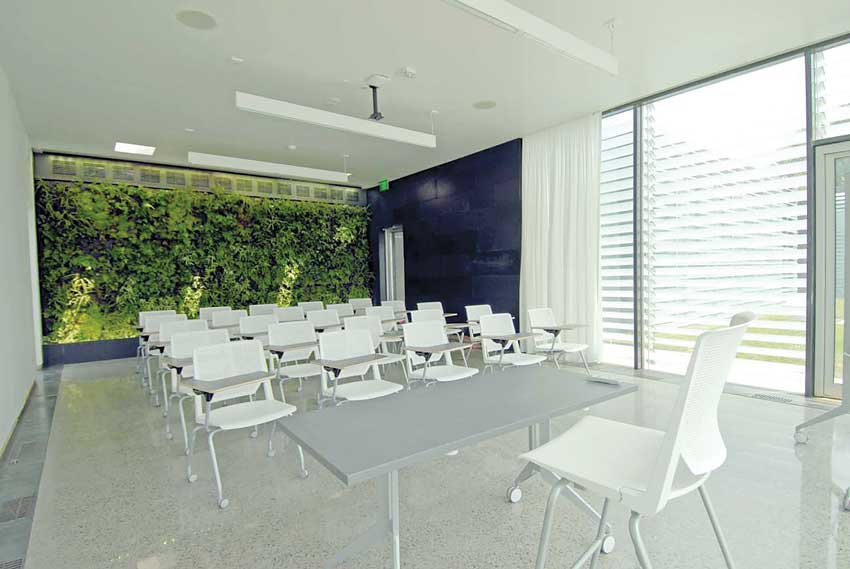
Photo courtesy of Studio 804
Variable refrigerant flow (VRF) systems can be used in very energy-efficient buildings to provide thermal comfort and integrate with other mechanical systems within a building.
Interior Space Flexibility
Collaborative teaching and group learning are concepts in education that have received a lot of attention and investigation in recent times. Whether school boards or educators are aware of current research topics or not, they often request architects to consider ways to incorporate spaces that can be flexible and transformed in size and character. Of course, that has to be easy to do and still allow for the spaces to function in terms of light, views, and acoustics. After all, the goal is to enhance teaching and learning, not detract from it.
One of the solutions being used increasingly in schools is operable glass walls made of panels that can be easily moved to define smaller spaces when they are closed and larger spaces when they are open. From a learning perspective, this solution allows the creation of defined areas for focused learning or the opening up of larger common areas where multiple students can work together on a range of activities utilizing shared resources, such as technology centers or presentation areas. Not only does this approach offer the sought after variety for student programming, but it also means that teachers can support each other, fostering a better-managed classroom environment. From an overall design perspective, creating such a flexible classroom configuration with operable glass walls can optimize or even reduce the needed floor space within a building envelope, which can translate into reduced construction costs.
Taking this flexible-space approach to the design of school environments can contribute to the following common requests from educators:
- Variable-sized group work: Operable glass walls enable separation of smaller groups for discussion, group projects, quiet zones, advanced or remedial work, test centers, teacher assistant-led groups, etc.
- Multiple concurrent activities: This approach allows teachers to monitor multiple activities in separated spaces.
- Outside volunteer space: When a parent or visitor volunteers in the classroom, they can use this area to work independently with students.
- Shared resources: Flexibly accessed glass walls offer common storage space for shared books, supplies, computers, and reduces redundant purchases.
- Teamwork: Joining two or more classrooms with shared space allows teachers to configure space to meet their needs, while advanced operating mechanisms allow for quick and easy transformations.
- Class management: One teacher can temporarily monitor two classes if another teacher has an emergency or needs a break.
- Minimized visual distractions: Use of mixed transparent glazing in the upper portion of the glass wall and opaque glazing in the lower portion allows seated students to be isolated from excessive distraction beyond the wall, while a standing teacher can monitor multiple spaces.
- Cool off/recovery area: This offers isolated, private space for behavioral and emotional issues or disciplinary actions.
Architects who have used this approach include John Brown, AIA, partner, Hollis + Miller Architects, who points out, “Connectivity, flexibility, and visibility were all very important concepts in the design of the spaces within our school projects. While we still needed the capability of closing off spaces for more traditional classroom and learning spaces, we also needed to open up the walls to accommodate larger groups, which would then allow for collaboration.” David T. Esely, AIA, senior project architect of the same firm, adds, “When closed, very little sound penetrates, which allows for diverse learning opportunities on both sides of the panels simultaneously. When the panels are open, the opportunities within the space transform and can then be tailored to specific instructors’ needs and requirements. This is all done with ease, speed, and frequency.”
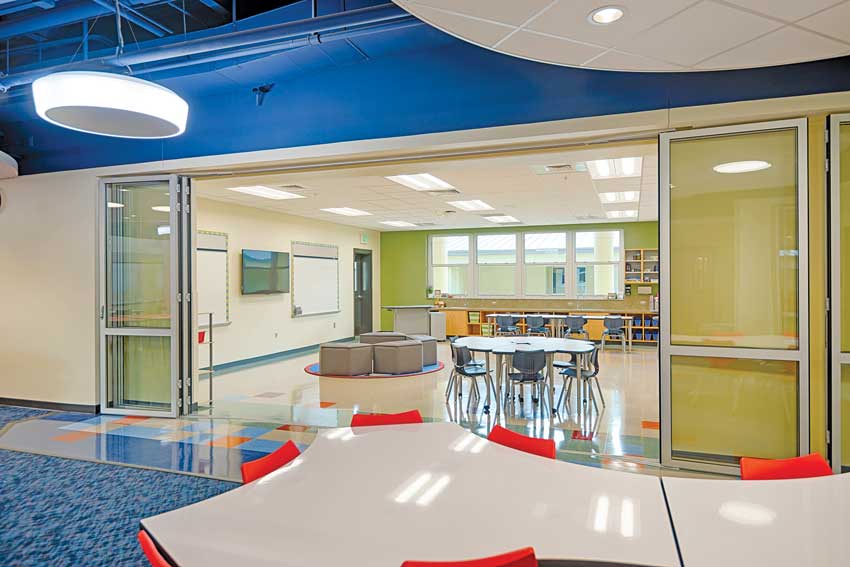
Photo courtesy of NanaWall Systems
Operable glass walls used in school settings allow architects to create flexible spaces that can meet a variety of educational needs and preserve the light, sound, and control aspects of design.
Interior Finish Protection
Schools are busy places with a lot of people and equipment moving daily. That means the interior finishes can get rubbed, bumped, banged, or even abused, and they will start to show signs of wear quickly if they are not inherently durable or protected in some manner. In these cases, material research and testing by independent organizations or manufacturers can help inform design decisions.
Interior Door Protection
Interior doors in a school are prone to get a lot of use and even abuse, which means that the materials used in them need to be able to withstand those conditions. Recognizing this need, door manufacturers provide product offerings that are specifically designed to handle these heavy use conditions. They also recognize that the doors need to meet other criteria for performance, such as fire ratings where required, acoustical control, and the ability to be easily maintained and serviced. Beyond performance, the door appearance is also important, so a variety of finishes have become available that allow doors to stand out as features in a design or blend in with the surrounding surfaces. Either way, some offer the option of customized appearances and even artwork or graphics being integrated into the door. Overall, they provide a durable, attractive, code-compliant, long-term door design solution.
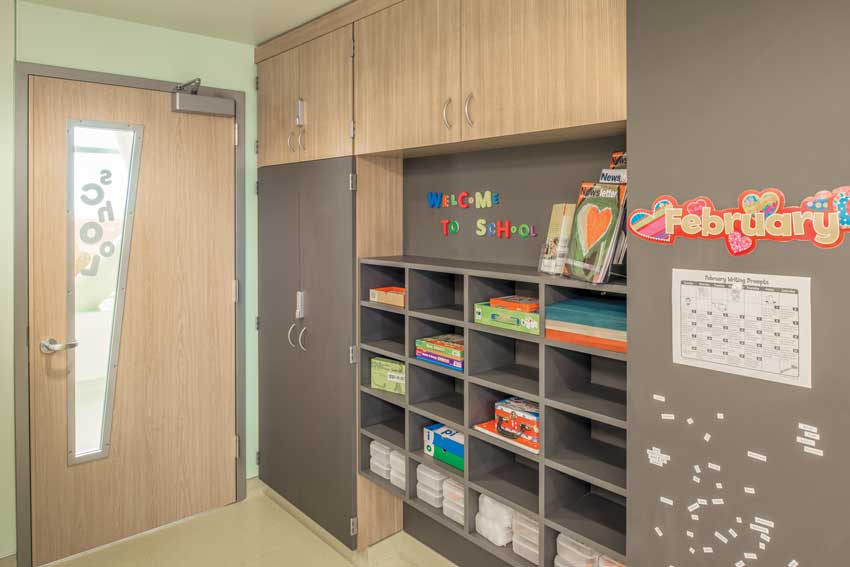
Photo courtesy of Construction Specialties
Doors that are fabricated and treated for heavy use can help with the long-term durability and appearance of school spaces.
Interior Wall Protection
Interior walls are at the forefront of the need for durability in a school. In particular, corners, edges, and other aspects of an interior design are subject to wear and tear from moving people or equipment. Adding products specifically designed to protect these areas is common, with many choices of product types, finishes, and colors to enhance, rather than detract from, an interior design scheme. For full wall areas that need protection, there are a number of choices. One is to use wall panels that are mounted over a substrate wall and incorporated into an overall design scheme. The other is to use rigid sheet protective wall covering that is readily available and easy to clean. Such coverings also come in specialty materials for unique or more demanding locations. One of the more creative choices though is the use of printed wall protection. In this case, the protective covering is clear and backed with a choice of standard or custom graphics such as logos, artwork, mottos, or mascots.
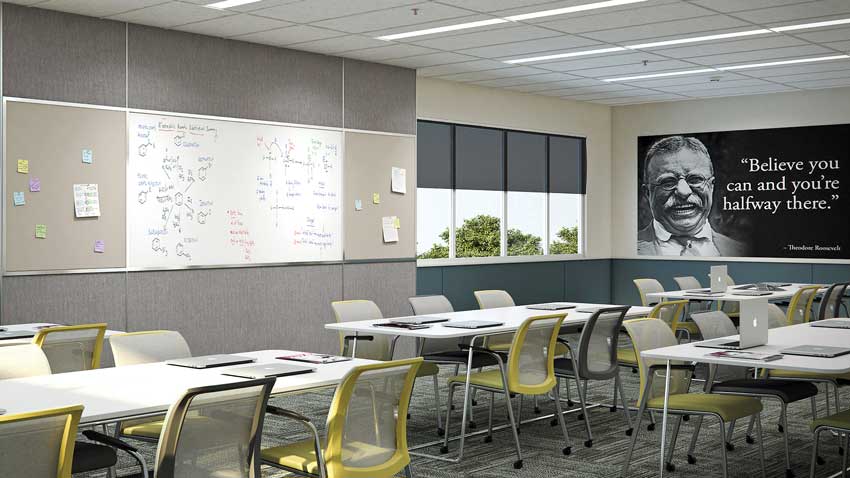
Photo courtesy of Inpro
Protective wall coverings in schools can take many forms to provide long-lasting, durable, and attractive design solutions, including digital imagery that inspires.
Printed Interior Wall Protection
There are occasions when wall protection is needed in a school but there is also a desire to have some printed graphics on a wall. That option is now possible and readily available. “When wall protection is selected that is printed with a design, it is important to recognize that these products are designed first and foremost as a highly durable, long-term wall protection solution that can stand up to years of abuse,” says Amy DeVore, business development manager with Construction Specialties. This benefit makes printed wall protection a sought-after choice for schools to control maintenance and replacement costs. But they also provide the ability to showcase visually stimulating imagery, like original artwork, school colors, mascots, or even eye-catching photography. Because artwork is dictated by creative direction, the design options are virtually unlimited. Artwork is printed and installed behind a clear, protective sheet that is all mounted onto the wall.
When specifying such printed interior wall panels, they can be selected as PVC-free and also meet the testing requirements of ASTM E84 Class A/1 fire characteristics. Commonly supplied in 4-foot-by-8-foot or 4-foot-by-10-foot rigid sheets, this product typically installs with a heavy-duty, water-based mastic adhesive and utilizes minimal sheet spacing, caulk, or trims to allow for proper expansion and contraction of the material. This is a break from the status quo of painted walls and metal school lockers, encouraging a collaborative and socially creative environment for students.

Photos courtesy of Construction Specialties
Walls can be treated with a clear protective surface that can include printed material on the back to create a fully custom look in school settings, as shown in a band room on the left and an athletic area on the right.
Restroom Privacy
Recent cultural shifts have moved architects and designers to think less about large school restrooms with ganged fixtures and more about providing greater privacy and gender-neutral options. Such creative solutions can defuse otherwise contentious situations and, in some cases, conserve square footage in buildings. This can be manifested in several ways, discussed as follows.
Toilet Stall Privacy
When it comes to designing and specifying toilet stalls, the first thing to realize is that there are options in partition heights and door-closing details that provide varying degrees of privacy and aesthetics. While individual, private restrooms are always an option (often used for gender-neutral accessible restrooms), American designers can learn some effective strategies from our European counterparts.
Comparing American toilet partitions to European-style partitions, the first thing that jumps out is that American partitions have no 3/8-inch gap between the swinging door and the pilaster that it closes against. European door and pilaster edges are designed to provide a shiplap-style edge condition so the two overlap, thus eliminating any visibility into the stall between the door and the pilaster. The hardware is factor here too. Typical American partition systems use door hardware that creates sightlines on the side of the doors. That’s because many of the latching mechanisms use a keeper that typically mounts on the striking pilaster, which requires a gap at the strike side to allow for the door to open or close freely. If a continuous piece is not provided, then there will be a sightline between the door and the pilaster. When switching to a shiplapped system, hardware that mounts on the side of the strike pilaster no longer works. Instead, the hardware must be able to mount separately to latch the door. Some European-style latches also incorporate occupancy indicators due to the fact that it will be almost impossible to see inside the stall to know if it is being used or not. To eliminate sightlines on the hinge side, a continuous hinge can be used that that allows either the door to be in closer contact with the mounting pilaster or uses the hinge itself to fill in the gap.
The next thing that becomes noticeable is the space above and below the door. In the American version, it is common to find the bottom of the door is about 14 inches above the floor, while the top of the door is about 14 inches below the headrail, commonly set at 83 inches above the floor. The standard resulting height of the opaque portion of an American partition is about 55 inches, or just under 4½ feet. In European-style partitions, the partition height can be increased to 62 or 72 inches with corresponding reductions in the spaces above and below, thus assuring greater privacy. It is also common to have full-height partitions that extend from the floor to the ceiling or a soffit above and create “full-room” compartments. These can still be created from partitions using customized sizing between 86- and 112-inch heights. Such prefinished partition systems can save time and money with very quick installations and less on-site construction and finishing if regular construction methods were used.
Part of the flexibility of full-room compartments and taller partition systems is that all common partition materials are still available. These include metal, stainless steel, plastic laminate, phenolic, and HDPE partitions. Each have their own capabilities, strengths, and weaknesses, but HDPE plastic stands out due to its features and benefits for schools. High-density polyethylene (HDPE) is a created from extruded polymer resin with a high strength-to-density ratio and is used in many different types of products. For school restroom partitions, it provides a mid-priced option with the lowest cost of ownership due to its low maintenance requirements. It resists mold, scratches, dents, chipping, rust, oil, and bacteria, thus offering greater durability than some other options. Its finish, with a wide variety of colors and textures, is assured to be a long-term solution since it is produced with a solid color throughout and never needs painting. Because of these attributes, it is common to find it with a 25-year warranty for quality products.
From a school health standpoint, HDPE partitions make a lot of sense too. They are available in low- or no-VOC products that are not a source of chemical off-gassing. Further, they don’t require paints or harsh cleaners that may contain VOCs either. Because they are non-porous solid surfaces, mold and mildew growth is resisted, helping with a healthier indoor environment. As such, they can contribute to points under the LEED green building certification program. Some even have earned GreenGuard Certification as administered by UL Environment. Overall, European-style HDPE partitions are proving to be a preferred choice for restrooms, offering extreme privacy, many design options, and innovative features that can significantly upgrade the look of a room and remain healthy and attractive for the long term.
David Casal is the director of sales administration with Scranton Products and has observed this trend, pointing out, “With unlimited design options, HDPE partitions are perfect for creating one-of-a-kind restrooms that really stand out from common designs for innovative facilities. Say goodbye to large sightlines, boring flat doors, and large gaps, and hello to stylish elegance with lots of privacy.”

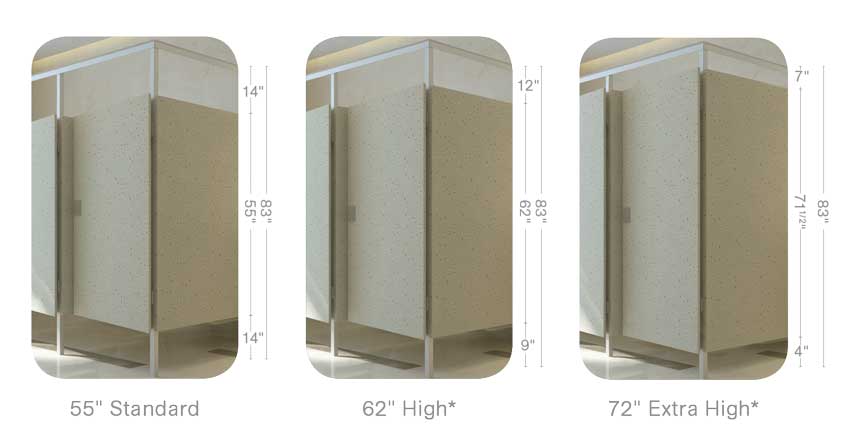
Images courtesy of Scranton Products
Toilet partitions no longer need to be limited to the American standard of 55-inch-tall partitions. Instead, products that provide greater privacy and separation are available in 62-inch, 72-inch, and full-height partition sizes.
Shower Stall Privacy
School gymnasiums with locker rooms and showers have been common programmatic elements of educational facilities. For decades, the norm has been to provide communal or gang showers in situations like this. The concept made sense since multiple showering “stations” within a given space increased efficiency and capacity while reducing mechanical first costs in new construction. But, as we have noted, times and culture have changed. There are new norms about bathing privacy that have raised new concerns and challenges related to bathroom and shower design. Further, additional risks of serious bacterial infections for athletes and other users put new focus on the design and surface cleanliness of communal shower installations.
One answer for increased privacy in showering is to use separated shower stalls or compartments instead of gang shower arrangements. To be effective, they need to include spaces not just for showering but also for adequate dry-floor changing that allow bathers to disrobe and get dressed. In designs where space may not allow the combined shower and changing area, then a more inline approach with individual showering spaces can be used.
Selecting a material for the shower stalls can be important to the health of students. Methicillin-Resistant Staphylococcus Aureus (MRSA) is a bacteria of concern here. MRSA is classed by the Centers for Disease Control (CDC) and the medical profession as one of the deadly “superbugs,” with infections considered extremely serious. There have been outbreaks of this bacteria in a variety of sports locker rooms that have prompted a number of recommendations for cleaning and disinfecting them regularly. The recommendations also include avoiding tile and grout, which can be damaged and harbor bacteria. Instead, the use of solid surface material can be an effective way to avoid any potential MRSA buildups and facilitate cleaning. Therefore, creating shower stalls with private changing areas all constructed out of solid surface materials will reflect the best current practices in this regard.
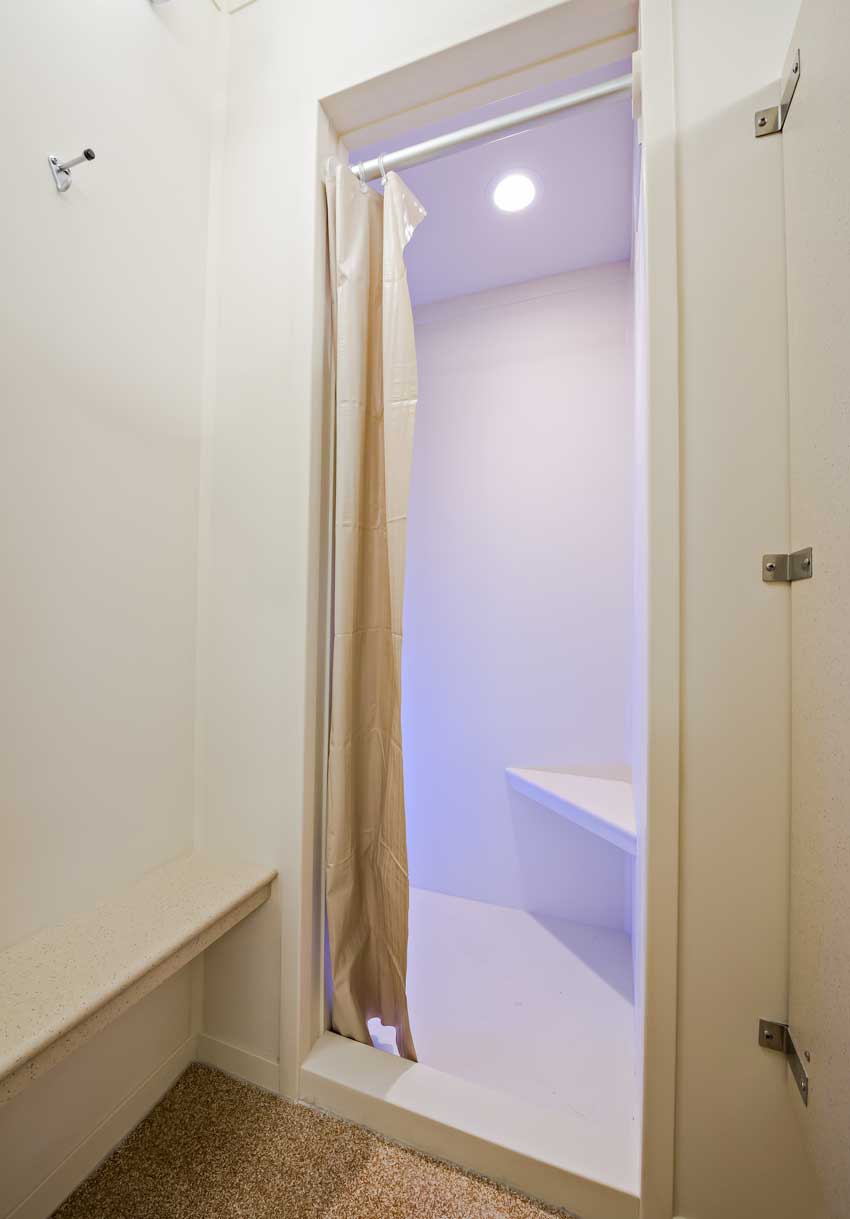
Image courtesy of Inpro
Private shower stalls with private changing areas all made out of solid surface materials offer safer, healthier alternatives to gang shower arrangements in schools.
Conclusion
School design requires an understanding of both building performance and conditions that are conducive for learning and teaching. This is true for exterior wall systems that incorporate controlled daylight to enhance the indoor environment. It is also true for creating vibrant, flexible, and durable indoor spaces that support building operations and programs for students. It even comes together in less-visible but significant ways in restroom design and HVAC systems. Architects and other design professionals who base their design decisions on research have more of a basis for successful design outcomes. This is true whether that research comes from organizations like the AIA Committee on Architecture for Education, academic institutions, or private firms and companies all focused on seeking truth and higher understanding of the interaction between people and the built environment.
Peter J. Arsenault, FAIA, NCARB, LEED AP, is a practicing architect, green building consultant, continuing education presenter, and prolific author engaged nationwide in advancing building performance through better design. www.linkedin.com/in/pjaarch

